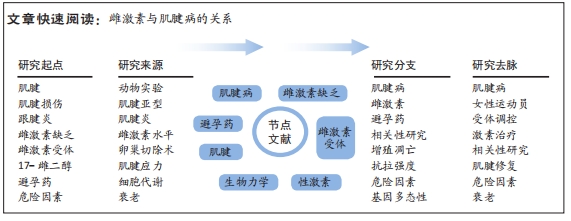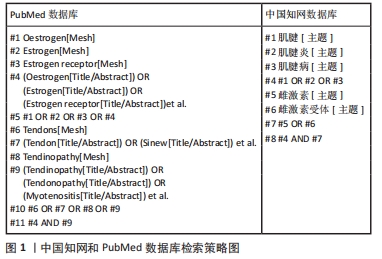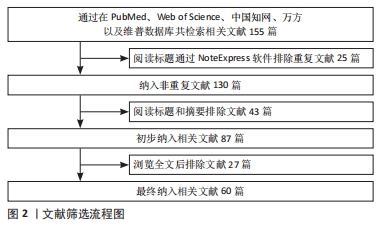2.1 雌激素亚型 雌激素分为动物雌激素与植物雌激素两种,每种雌激素有许多亚型。文章从已研究较多的3种雌激素亚型展开,总结讨论雌激素亚型与肌腱病的相关性。
2.1.1 植物雌激素 植物雌激素是一类具有类似动物雌激素生物活性,与哺乳动物结构相似,具有弱雌激素作用的化合物[15],文章主要以人参皂苷和染料木素两种植物雌激素阐述相关性。人参皂苷Rg1是一种天然植物雌激素[15],可以增加雌激素反应元件的荧光素酶活性,具有抗氧化和抗衰老作用。WU等[15]在跟腱炎(achilles tendonitis,AT)对照组与Rg1处理组大鼠的研究中,发现处理组大鼠肌腱调节蛋白和与肌腱发育和分化的两种关键转录因子的mRNA水平显著升高,这代表大鼠跟腱组织的生物力学特性中的负荷能力相应增加,研究证实Rg1在患有肌腱炎时会通过促进肌腱细胞增殖和迁移的方式从而修复损伤的肌腱;此外研究也采用免疫印迹法和实时荧光定量聚合酶链式反应检测对照组与处理组大鼠肌腱细胞凋亡相关基因的表达,发现Rg1能够通过抑制跟腱炎大鼠模型肌腱组织的炎症反应来减轻细胞凋亡,进一步说明Rg1在肌腱炎中能够通过促进肌腱细胞增殖,减轻细胞凋亡的方式修复肌腱,有助于肌腱维持正常的稳态环境。
染料木素是一种植物衍生的,在大豆中天然存在的异黄酮植物雌激素[16]。CARROLL 等[17]通过对染料木素在雌激素缺乏症大鼠肌腱作用的研究中发现,染料木素可以防止雌激素缺乏期间的胶原蛋白丢失,改善雌激素缺乏的大鼠的肌腱功能,使肌腱应力效应增加,但其改善肌腱损伤的机制并非重塑胶原蛋白,而是主要作用于细胞增殖相关的基因。
2.1.2 动物雌激素 除植物雌激素外,动物雌激素也被证实影响肌腱功能特性。动物雌激素是一类由卵巢分泌的有广泛生物活性的类固醇化合物,主要有雌二醇、雌三醇、雌酚等。文章主要以雌二醇阐述相关性[18-19]。
17β-雌二醇(17β-estradiol,E2)是一种动物雌激素,同时是一种具有抗炎作用的免疫调节剂[18-19]。WANG 等[18]和MAMAN等[19]在不同剂量E2处理跟腱炎大鼠模型的实验中发现,实验组Ⅰ型胶原相关基因α1-Ⅰ型胶原基因、α1-Ⅲ型胶原基因的mRNA表达水平和细胞外基质组成成分相关基因核心蛋白聚糖、腱生蛋白C的mRNA表达水平都有相应提高,而对照组的白细胞介素1β、白细胞介素6及肿瘤坏死因子α等炎症细胞因子均有所升高,证实雌激素E2能够改善跟腱炎大鼠模型的肌腱退变,使肌腱刚度和抗拉强度效应增加以及通过降低炎症细胞因子的方式减轻炎症,其机制也与调控细胞增殖和凋亡相关基因有密切的联系。在一项E2处理小鼠咀嚼肌肌腱细胞的研究中,观察到肌腱增生的现象,同样证实E2能够促进细胞增殖相关基因的表达,并且也能够促进肌腱细胞分化[20]。
此外,在多项服用含炔雌醇的口服避孕药对抗阻训练适应影响的研究中,与对照组相比,雌激素补充和运动的联合作用增加了胶原纤维的合成效率,而口服避孕药使用者的肌腱胶原蛋白转换较慢[21-23],说明雌二醇增加了肌腱胶原的合成和肌腱胶原的整体周转,有助于维持肌腱的稳定和修复肌腱的损伤。
关于雌激素亚型和肌腱病相关性实验的研究结果见表1。综上,许多关于雌激素种类对肌腱损伤影响的研究都发现雌激素在修复肌腱的过程中起到了有益作用,体内研究表明雌激素可促进肌腱的合成代谢。也有体外实验证明多种雌激素对肌腱能够起到促进肌腱细胞增殖、减轻炎症和细胞凋亡的作用,使肌腱刚度和抗拉强度增加以及应力增加,但实验大都局限于动物模型,关于此结论能否应用到人体,还需要更多实验验证。
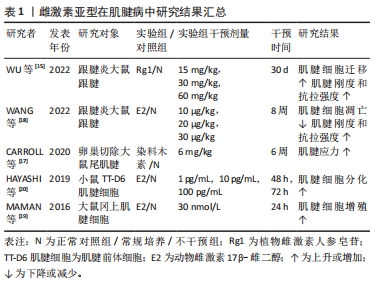
2.2 雌激素受体 雌激素受体属于一种蛋白质分子,主要包括两大类,一种是两个细胞内激素核受体[24-33],被称为雌激素受体α和β;一种是位于内质网的视紫红质样G蛋白偶联膜性受体。由于目前的研究主要集中在经典的核受体上,限制于膜性受体的实验较少,证据不充分,故在此主要阐述经典核受体雌激素受体α和雌激素受体β。
临床研究发现,乳腺中E2会根据其受体的亚型调控不同的表达,与雌激素受体α的结合促进细胞增殖,而与雌激素受体β的结合则抑制增殖并促进分化,这表明即使是同一种激素,与不同受体结合,其表达也可能会产生不同甚至相反的结果[13]。
SHEN等[24]的实验证实,雌激素受体β的表达与狭窄性腱鞘炎的严重程度有关。狭窄性腱鞘炎初期时,β受体即开始表达,且在炎症中期达到高峰,但在其他阶段,则表达无显著差异。其他实验也观察到绝经后腕管综合征妇女的肌腱细胞和滑膜组织中雌激素受体β过表达的现象[25-26],证实在肌腱病中雌激素很可能通过增加雌激素受体β过表达的方式促进炎症和血管生成,从而加速炎症进程。在对胫骨后肌腱功能障碍的研究中,观察到男性和女性患者的正常和病变肌腱均表达两种雌激素受体[27-28]。不仅如此,在男性和女性撕裂的冈上肌腱与对男性和女性肌腱细胞细胞核的研究中发现,雌激素受体β在绝经后女性样本中的表达明显高于男性样本[13,19]。相比之下,雌激素受体α在男性和女性之间无显著表达差异,进一步证实β受体在肌腱病中发挥的作用,也侧面反映了雌激素受体α在肌腱病中并未占据主导作用。
此外后续的研究中,DEHGHAN等[29-30]在雌激素受体α和β介导松弛素受体表达的研究证实雌激素受体β的过表达会通过上调松弛素受体表达的方式使得大鼠髌腱与膝关节相关韧带的松弛和膝关节被动运动范围的扩大。而多项小鼠跟腱愈合的研究均发现雌激素受体β缺乏会通过影响脂肪形成和Ⅰ型胶原蛋白形成的方式在肌腱损伤的修复中产生不利影响,使肌腱应力、抗拉强度以及横截面积等生物效应降低,具体则表现在细胞增殖减少和凋亡增多等方面[31-33]。在一项诱导大鼠处于类似人类绝经后雌激素缺乏状态的研究中同样也支持上述结论[34]。
关于雌激素受体和肌腱病相关性实验的研究结果见表2。通过以上实验可以发现,在雌激素受体α和β中,雌激素受体β更多的在肌腱损伤和修复过程起作用,而雌激素受体α暂未发现能够在肌腱损伤过程中产生主要影响。雌激素受体β的表达使肌腱横截面积增大、应力增加以及研究对象相同时间运动增强,研究证实其通过影响脂肪形成、Ⅰ型胶原蛋白的沉积和减少肌腱细胞凋亡来修复肌腱,而其过度表达则可能会促进炎症和血管生成,从而推进炎症进程,在肌腱损伤中发挥作用,但由于量效关系不统一且大都局限于动物模型,结论仍需进一步临床验证。
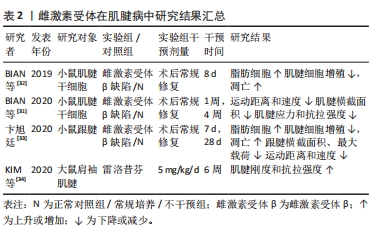
2.3 雌激素水平
2.3.1 高水平雌激素 流行病学调查显示,在年轻和健康的女性中,当雌激素水平较高时,前交叉韧带和附着于膝部的相关肌腱的弹性高于平常[35-36]。而高水平的雌激素在绝经后大转子疼痛的女性患者调查中被推测可能与肌腱稳定之间存在相关性[36]。有研究在人体跟腱应变特性的研究中观察到较高的雌激素水平会降低小腿三头肌肌腱的稳定能力[35,37],并推测可能是高水平雌激素能够改变肌腱活动周期时的能量储存,从而导致损伤发生率的升高。
不仅如此,在一项肥胖女性与男性髌腱僵硬度比较的实验中,发现女性髌腱僵硬度低于男性[38]。实验者认为这种现象的可能原因是雌激素水平的升高与肥胖因素的结合会导致胶原合成减少,并使得肌腱的刚度下降。而在活跃的年轻女性运动员中,高水平的雌激素浓度可能会使肌腱和韧带损伤的风险显著增加[35,39-40],因为高水平的雌激素与高于日常运动量结合似乎会降低对胶原合成的机械负荷的反应性,并与增强的关节松弛相关[41]。这与上述实验的结论也具有一致性,即高水平的雌激素在目前的研究中均发现对肌腱稳态具有负面效应,这种影响会从肌腱弹性、刚度和松弛度各方面产生,并且其会与肥胖、运动等因素相互作用影响肌腱稳态。
2.3.2 雌激素缺乏 除从高水平雌激素浓度探究对肌腱病的影响外,更多实验也会探究雌激素缺乏状态下肌腱产生的各种变化。
在接受卵巢切除术的大鼠中,雌激素缺乏状态已被证实会恶化骨-肌腱愈合的生物力学特性,并抑制修复组织中软骨组织的形成[42]。有研究在对去卵巢、青年和老年大鼠跟腱分离体外研究中,证实衰老和雌激素缺乏对肌腱代谢和愈合均会产生不利影响[6,8-10,34,42-45]。而HSIEH等[46]在雌激素受体β与大鼠肌腱病进展关系的研究观察到病变大鼠的雌激素受体β表达和凋亡细胞数量更高,并与疾病的严重程度具有相关性,其机制是雌激素缺乏状态下通过上调雌激素受体β水平和诱导细胞凋亡从而推进疾病进程,加重病情。IRIE等[47]的研究也发现绝经后雌激素缺乏可能会下调肌腱胶原周转,降低肌腱弹性、应力以及刚度和抗拉强度,故而雌激素缺乏会对肌腱代谢和愈合产生负面影响[48]。因此,在性腺功能低的绝经状态下,雌激素补充治疗是对肌腱有益的方法选择[48],它有助于使肌腱正常化。初步研究表明,雌激素替代治疗至少对活跃的绝经后妇女是有益的,并可能降低下肢肌腱和韧带损伤的风险[41]。不仅如此,雌激素水平对肌腱病影响的效果是一个缓慢渐进的过程。在月经周期对在体腓肠肌内侧肌腱力学性能的研究中发现[49-52],雌激素的急性波动对腓肠肌内侧肌腱的力学性能没有显著影响,在肌腱损伤时的雌激素治疗并没有导致短时间内肌腱力学或组织学参数的改变[51]。急性短暂的雌激素缺乏状态下的肌腱力学性能似乎也无明显相关性。因此,雌激素补充治疗也需要一个长期坚持的疗程才能在肌腱病中产生影响。
关于雌激素水平和肌腱病相关性实验的研究结果见表3。综上,正常水平的雌激素有益于肌腱损伤修复,而雌激素缺乏状态和过高的雌激素水平对肌腱愈合都是不利的。雌激素对肌腱修复的作用尚未完全阐明[14],似乎取决于女性的年龄和激素状态、病灶中肌腱和韧带的特定类型,以及组织的机械负荷程度。内源性雌激素也被证明能促进大鼠跟腱模型的愈合。动物研究显示,雌激素缺乏可能会降低肌腱的胶原合成效率,肌腱弹性下降,抑制肌腱的合成代谢,不利于肌腱损伤的修复,而正常水平的雌激素可能对肌腱中Ⅰ型胶原合成有刺激作用,促进肌腱细胞增殖和代谢,这为雌激素作为肌腱病修复的一种治疗策略提供依据,但由于实验给药方式以及动物模型不统一等原因,还需更多学者对该领域进行研究。
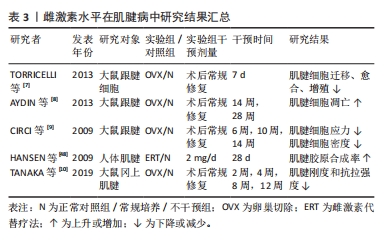
2.4 雌激素对肌腱病影响的分子机制 截至目前,雌激素在肌腱病中发挥作用的分子机制尚未完全阐述清楚,文章将从所研究的分子机制中进行初步归纳总结。
2.4.1 雌激素受体β方面 小鼠跟腱愈合的研究中分别描述了早期阶段雌激素受体β缺失导致肌腱细胞增殖减少[31-33]、细胞凋亡增加和影响Ⅰ型胶原蛋白形成的分子机制。前者通过上调过氧化物酶体增殖物激活受体γ信号通路,肌腱瘢痕中脂肪细胞浸润增多,形成异常愈合;后者则是在细胞外基质重构中通过调节干扰素调节因子5-趋化因子配体3轴,下调其表达,使Ⅰ型胶原蛋白合成受阻,干扰跟腱愈合。
2.4.2 雌激素E2方面 而对雌激素影响肌腱细胞增殖的分子机制研究中[7-10,15,17-20,48],在不同剂量E2处理跟腱炎大鼠模型的实验中[18-19],通过对细胞凋亡相关基因的mRNA水平的检测,证实E2治疗可减轻跟腱炎大鼠模型中的肌腱细胞凋亡,其分子机制是E2通过调控雌激素受体α和PI-3K-Akt信号通路(PI-3K-AKT是细胞中一个经典的信号通路,它是一条与磷脂酰肌醇有关的信号通路,也是RTK介导衍生的信号通路,在胰岛素的刺激以及细胞生存当中发挥着重要作用),从而降低炎症细胞因子和调控肌腱细胞增殖与凋亡,进而治疗跟腱炎。而在雌激素缺乏的实验动物模型研究中作者推论钙离子是激活部分细胞凋亡的信号传递机制的重要组成部分,由于缺乏雌激素对钙代谢调节的作用,细胞内信号中断可能导致肌肉、肌腱、骨骼和半月板细胞的凋亡增加[52],通过雌激素调节钙离子的分子机制从而对肌腱修复产生负面影响。
2.4.3 其他方面 在基因层面的研究,PONTIN等[53-54]在对绝经后胫骨后肌腱功能障碍研究中发现雌激素受体α基因XbaI的单核苷酸多态性可能导致肌腱病,而A/A基因型可能是该人群中胫骨后肌腱发生肌腱病的危险因素。而在胫骨后肌腱病患者雌激素受体多态性的研究中也观察到雌激素受体1基因具有Xbal单核苷酸多态性的患者发生胫骨后肌腱病的风险更高[54-55]。多项研究从基因层次解释肌腱病的危险因素,表明特定基因影响肌腱病的可能性。
此外,在口服避孕药的研究中发现使用者AT菌株减少,被认为与雌激素对胶原蛋白合成反应的影响有关[21,55-59]。随着雌激素水平的增加,Ⅰ型胶原mRNA的增加减少。因此,由于单相口服避孕药而导致的血液雌激素可用性的长期降低被认为增加了运动诱导的胶原蛋白的产生;而非单相口服避孕药使用者在整个月经周期中血浆雌激素的急性波动并没有改变跟腱的应变行为,相反,单相口服避孕药使用者长期接触雌激素减弱导致跟腱拉伤减少,这被认为是由于内源性雌激素对胶原合成的影响。而在雌激素诱导胶原蛋白重定向的研究中观察到生理和实验上的雌激素水平升高会引起胶原纤维的重新定向,主要垂直于肌肉长轴[56-57]。研究的结果提供了定量数据,表明了肌腱损伤修复中雌激素引起大鼠肌层胶原纤维的主要重定向的分子机制。
关于分子机制,还有一种推测是雌激素水平通过影响人类内分泌系统的其他激素成分而发挥间接影响[58-59]。女性体内高水平的循环雌二醇已被证明与低水平的循环胰岛素样生长因子有关,这是一种可能与运动中胶原合成增加的程度直接相关的物质。因此,性别差异可能不是雌二醇的直接影响,而是雌二醇对循环胰岛素样生长因子的影响。在雌二醇对运动后肌腱的研究中观察到运动后24 h内,肌腱胶原合成会进行选择性的增加,这与实验雌二醇抑制运动诱导的人肌腱胶原合成的假设相符[56]。实验者推测其分子机制可能是高水平雌二醇通过降低游离循环胰岛素样生长因子水平的间接作用。
目前该领域关于表型研究相对丰富,但对于分子机制和信号通路研究较少,关于雌激素在肌腱病中的信号转导通路研究汇总,见表4。
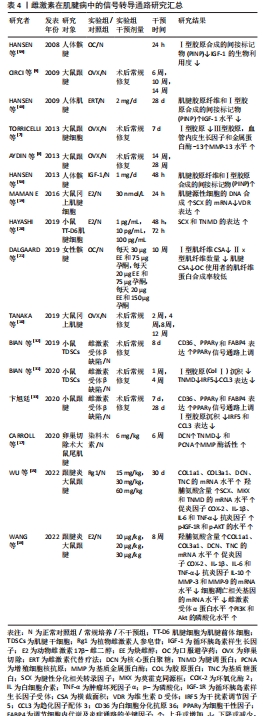 文章对目前已有研究的三种共有分子机制进行了初步归纳总结,详见图3。
文章对目前已有研究的三种共有分子机制进行了初步归纳总结,详见图3。
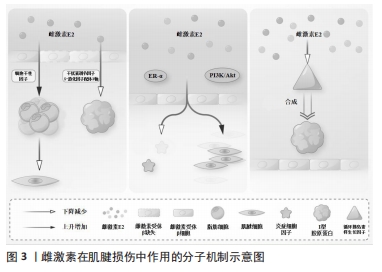
综上,目前雌激素在肌腱损伤中作用的分子机制尚未完全阐释,更多实验围绕肌腱胶原合成和细胞增殖凋亡,仅有少量文献研究了雌激素受体β缺陷调节干扰素调节因子5-趋化因子配体3轴、E2调控雌激素受体α和PI-3K-Akt信号通路和高水平雌二醇降低游离循环胰岛素样生长因子水平3方面的分子机制。目前实验对雌激素在肌腱病中作用的分子机制和信号通路研究解析并不透彻,图表就现有发现进行初步归纳,为后续学者提供研究基础。

